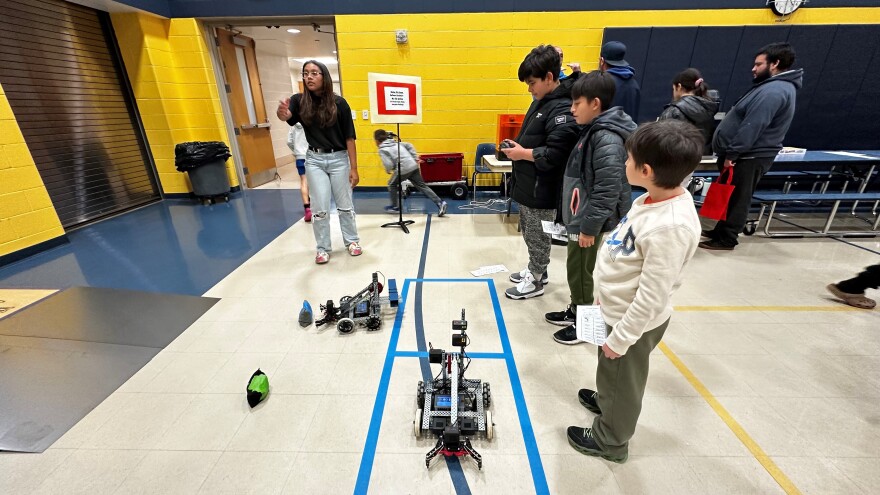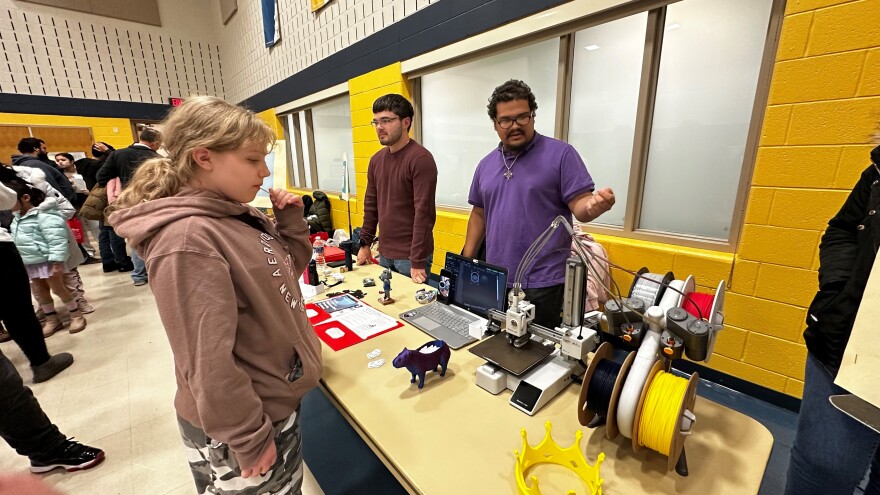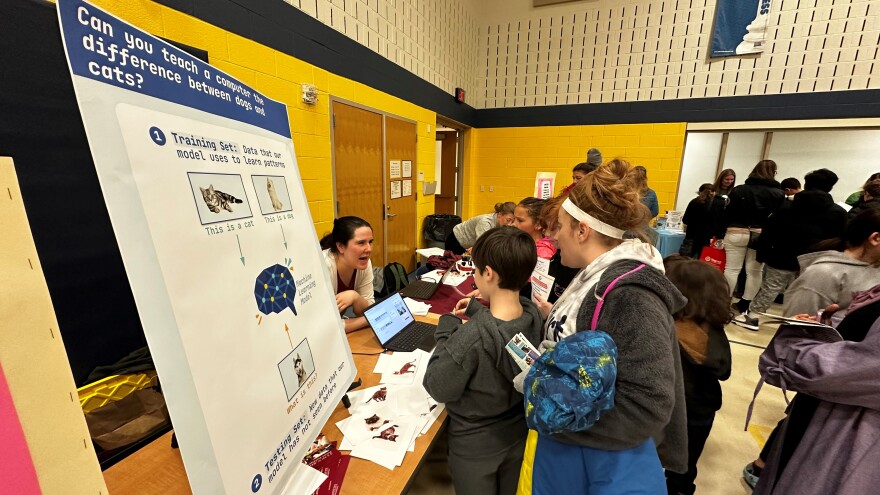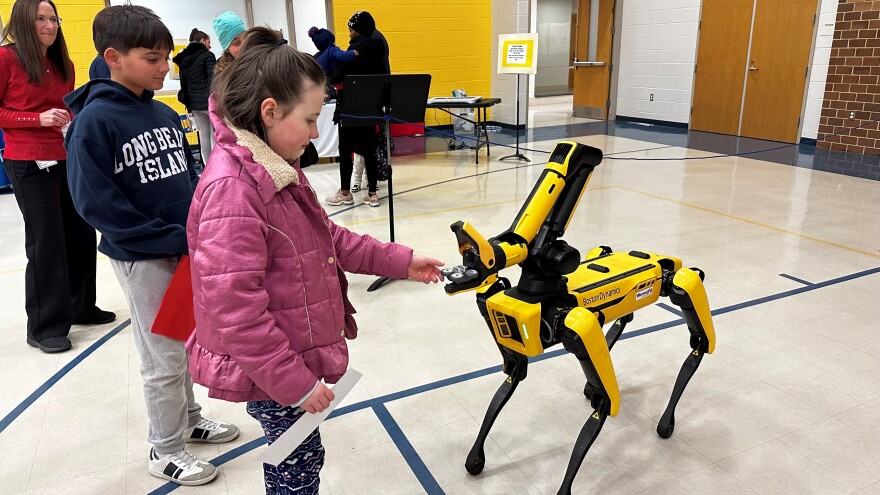WILSON BOROUGH, Pa. — Hundreds of young students and parents came out Thursday to partake in some exciting hands-on activities for the second annual Family Computer Science Night.
The event, at Wilson Area Intermediate School, showcased computer technology in an accessible and understandable fashion for kids from kindergarten through eighth grade.
It included opportunities to play with robot dogs, learn about 3D printing and plot out a program to rescue toys from a fearsome dragon.
Family Computer Science Night falls right into Computer Science Education Week, a national event which runs Dec. 6-12.
Experts from across the Lehigh Valley — professors at local universities, college science clubs and more — introduced students to incredible scientific applications fun and engaging for a young crowd.
It all was meant to plant a seed of wonder that hopefully could sprout into a career in science.
Judging by all the excited faces throughout the school, it sure did work.
As kids ran from station to station, they learned new things about computers, AI, robots, machine learning, drones and more, accumulating stamps from each stop for a chance to win a prize.
And it was all driven by learning.

See Spot run
Warren County Community College Warren UAS Director of Operations Dennis Florentine said the demonstration of Boston Dynamics’ Spot the robot dog is “always an attraction, wherever we go.”
“The children like him, the high school kids like him. It’s a good opportunity to see a ground robotic device, as opposed to quadcopters and fixed-wing aircraft,” Florentine said.
“We bring this down, and people say, ‘Well, what can it do?’ They can be used in law enforcement, fire rescue, construction, and search and rescue. The New York City Police Department has a few of these walking around right now.”
Florentine said the spectacle of Spot helps start a conversation about robotics and helps students realize it’s more than just a toy, but a valuable tool they could possibly work with one day.
Lily Riley, 8, said she was excited to see all the displays at the event, but it might be hard to beat Spot, who she visited first.
“I think they’re mostly entertaining, and that’s a fun way to get involved [with coding]."Theadora Morales
“It was cute. My teacher and I are very into animals,” Riley said, adding she is very interested in science as well.
Theadora Morales, 14, who is part of the WASD computer club, helped challenge young students to drive a sorting robot to pick up a sandbag and drop it in a cornhole before the club’s programmed bot did the same thing.

Morales, who said she joined the club for fun, said that around half an hour into the event, only one student had beat the programmed robot, but it did serve as an entertaining way to introduce kids to robotics and programming.
“I think they’re mostly entertaining, and that’s a fun way to get involved [with coding],” Morales said.
Teaching tools and learning opportunities
Assistant Professor of Computer Science at Lafayette College Sophia Serrano manned a station showcasing Google’s Teachable Machine, and explained to students how it learns, as well as the limitations it had for comprehending new information.
"Today, we're using Google's Teachable Machine as a visual platform to help people understand machine learning models better. This is a platform that learns to adjust a very simple model based on just a few examples to tell the difference between categories,” Serrano said.
“And so we're having kids test it by showing a few examples of cats versus dogs and then trying to see when the computer messes up at telling cats versus dogs and when is actually correct. So far, we've gotten a lot of discussion of how much better they are than telling cats versus dogs than the computer.”
Serrano said the fun format led to plenty of engagement with young students, including one who wanted to know exactly how she got into the field.
“And so I got to talk a little bit about my journey into AI, and I’m hoping that some kids maybe are getting some interests that might follow them up through college,” Serrano said.

Teacher Amy Hertzog and her daughter Audra, 7, came out to the Family Computer Science Night to see some fun and inspiring demonstrations.
The pair teamed up to take on Moravian University’s “Toy Rescue” life-sized coding challenge, which had Audra lay out a list of programming instructions that her mother had to follow to rescue a toy figure from a giant dragon.
“I learned how to program stuff to make things move, and how the computer doesn’t think like you’re thinking,” Audra Hertzog said, adding she had fun learning how to “debug” her mom’s instructions in order to orchestrate the rescue program.
Amy Hertzog said she found the display perfect for younger children, who had an easier time grasping difficult concepts with activities like the challenge.
“It was very fun and informative for younger age children who don't conceptualize the things that we do on the computer, that have their own sort of coding language, and so we have, for someone like her, who's seven, helped her see that sometimes our brain doesn't work like a computer,” Hertzog said, adding Audra was also enamored with Spot and a few drone displays as well.
3D printing a passion for science
Treasurer of DeSales University’s Computer Science Club Justin Rice drew quite a crowd of kids with his 3D printer setup, along with a display of creations – including pen holders, a princess crown, a blue capybara, and an extendable lightsaber-esque sword — who quickly became intrigued by the device and how it works.
“So tonight, we are demonstrating our 3D printer and 3D printing technologies, along with the slicing software that we use to prepare models for 3D printing,” Rice said.
“Slicing is, to put it in simple terms, it takes a 3D model, and it converts the structure of the model into mathematical instructions for how the tool end of a printer should move to create the model. And if there's any conflicts, it will alert the user of said conflicts.”
As children witnessed a new device 3D printing at the table, they asked questions about how the printer works, what goes into a design, and, of course, if it was possible to buy such at setup.
“So I’m hoping that this is kind of a gateway for kids, to show them that it is accessible, it is easy to get into."Treasurer of DeSales University’s Computer Science Club Justin Rice
Rice explained his rig cost about $350, which makes for a pretty accessible price point for hobbyists or families interested in drumming up an interest in science.
It’s also a good starting point for kids to learn, and potentially grow a hobby into a passion that could take them even further into the future – just as the organizers behind Thursday’s event intended.
“I’ve been interested in 3D printing for a couple of years, but I always started with the assumption that ‘Oh, it’s too expensive for me, I could never afford this,’ or ‘I don’t know how to get started,’” Rice said.
“So I’m hoping that this is kind of a gateway for kids, to show them that it is accessible, it is easy to get into. You just have to know where to start. And I’m hoping tonight that we are able to provide an entryway to students to get interested and get involved.”


